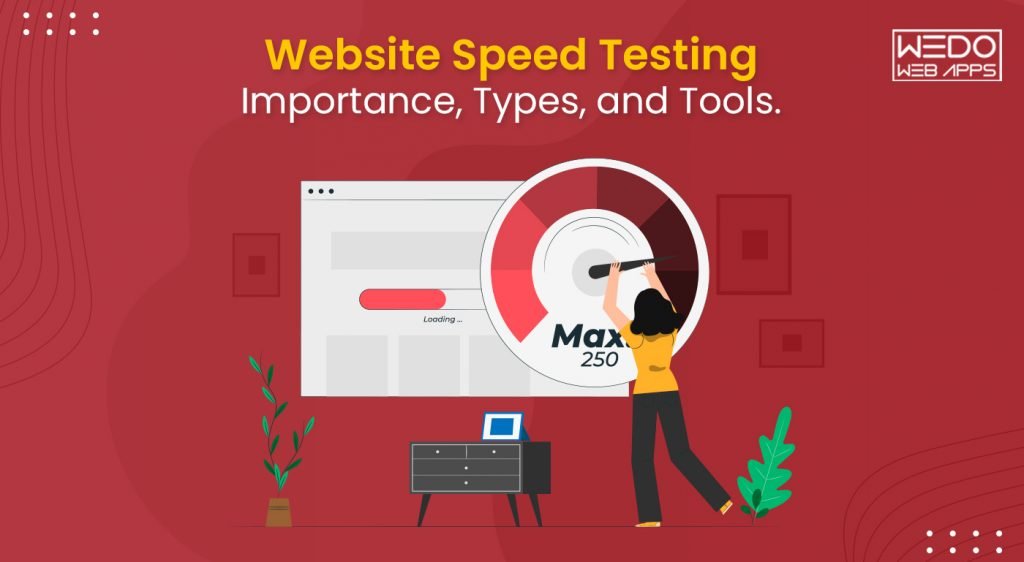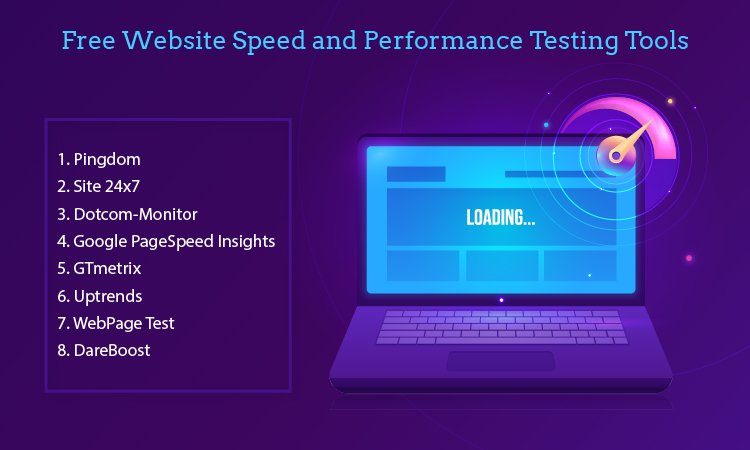19 Oct, 2022 | Responsive Web Design Services
Website Speed Testing - Importance, Types, and Tools

What is the Importance of Website Speed?
Speed can either make your website or break it. This is the reason why website developers, marketers, analysts, and IT departments are more focused on website speed testing tools. Improving your website speed and performance metrics can significantly impact your overall website performance, thereby helping you achieve your success goals. Page speed impacts your website in almost every area, from user experience to search engine optimization. We have seen that most of the website users will not wait for more than 4 seconds on a web page to load before moving on to some other store. And this is a fact that faster loading websites will perform better in the market. But how to determine the speed of your website? Just sitting in front of your computer, looking for your website to load in order to determine the speed. Is it the solution? Absolutely Not. That is why most of the developers and testers will take advantage of the wide range of performance testing tools for thoroughly testing scenarios. Before knowing various tools for speed testing your website, you should know that there are many other kinds of performance tests that need to be performed on a website. Read further to learn more about types of website performance tests.Types of Website Performance Tests
Performance tests are the non-functional tests done to check the responsiveness, scalability, and throughput of the website under test. This mainly helps in increased revenue generation and enhanced user experience. Below is the wide range of performance tests that can be done on your website.- Performance Test: Performance testing means checking the website's scalability, responsive website design, and speed.
- Load Test: This test is done to check and verify how the website performs under load.
- Stress Test: This helps the tester note how the system works under extreme load conditions. Stress tests help identify the issues related to synchronization, memory leaks, etc.
- Capacity Test: This is to identify how many users/transactions a website can handle at a particular time.
- This test is done to ensure whether the system will be able to take an expected load for a more extended period.
How to Perform Web App Performance Testing?
Before you start testing your website or web application performance, you should keep a few things in your mind. Following are the considerations:- Understand the website's purpose, identify whether it contains any payment gateways, web services, or anything related.
- You should always know the reason behind testing the website. Always understand the things to be measured, such as speed, number of customers, volume, response time, etc.
- Know the expectations of your customers.
- Project schedule and the QA Window
- Availability of resources and QA tools
Steps to Perform Website Testing
- Setup the Physical Test environment like hardware, software, tools required for testing your website.
- Design Test plans according to the criteria, ensure covering all possible testing scenarios
- Now, test the website for one user to ensure that the setup is correct
- Imitate the workload as per the plan. Then execute the test with different workloads. Now monitor the tests for Resource utilization.
- Now that you are done with testing, analyze the results, and identify the areas having bugs and errors.
- The issues should be reported with as much detail as possible. There are many website testing tools that also provide the remedy for the bugs.
Free Website Speed and Performance Testing Tools
 Now that you have a lot of understanding about website testing, check out these tools for testing your website's speed. Each tool offers its unique features, reporting, and different ways to show results.
It is essential to know that the DNS lookup will be slower when you are running these tools for the first time. Therefore, it is recommended to run the tests multiple times and take an average of the overall results.
Now that you have a lot of understanding about website testing, check out these tools for testing your website's speed. Each tool offers its unique features, reporting, and different ways to show results.
It is essential to know that the DNS lookup will be slower when you are running these tools for the first time. Therefore, it is recommended to run the tests multiple times and take an average of the overall results.
- Pingdom
- Site 24x7
- Dotcom-Monitor
- Google PageSpeed Insights
- GTmetrix
- Uptrends
- WebPage Test
- DareBoost
What is meant by Automated Website Testing?
Automated Website Testing is meant by the process of automating the user scenarios on a website to test its behavior on multiple aspects. The QAs make these user scenarios with an automation framework such as Selenium to mimic user interaction on the UI of a website. A website undergoes various modifications during the entire development lifecycle. After each change, a website needs to be tested across numerous hardware configurations and different OS. Performing such complicated tests manually can be time-consuming and very expensive. Therefore, Automation is essential for testing your website.Improve Your Speed, Attract Audience, and Win the Race
The tools above-mentioned can be very helpful for you to travel on the pathway of improved website performance. However, each of the tools mentioned above has its unique features, and it is up to you to test these tools and figure out which one works best for your requirements. We think that speed testing is something that should be done right after you have finished developing the website. Testing the website makes it more responsive, scalable, and optimized to search engines. Over time, things are going to change, and if you use these tools, you will be a step ahead of your peers. Hiring a Website Speed Testing Company will help you tackle different challenges, improve website performance, and deliver the best user experience to the customers. WeDoWebApps LLC can efficiently help you with that journey. Not only testing, even if you are looking for full-cycle website development and testing services, WeDoWebApps LLC can help you with your requirements. We offer the leading responsive website design services across the globe. Feel free to contact us anytime you have a query related to our services.Frequently Asked Questions
Website speed testing refers to the process of measuring how fast a website loads and performs various functions, such as page rendering, script execution, and resource loading.
Website speed is a critical factor that affects user experience, search engine rankings, and overall business success. Faster websites tend to have lower bounce rates, higher engagement, and better conversion rates.
There are several types of website speed testing, including:
- Page speed testing: measures the time it takes for a webpage to fully load and display all its elements
- Server speed testing: measures the response time of the web server to requests
- Connection speed testing: measures the bandwidth and latency of the user's internet connection
- Synthetic testing: simulates user interactions with the website to test performance under different scenarios
- Real user monitoring: tracks actual user interactions and measures website speed and performance based on user data.
There are many website speed testing tools available, both free and paid. Some popular ones include:
- Google PageSpeed Insights
- GTmetrix
- Pingdom Website Speed Test
- WebPageTest
- YSlow
- Lighthouse
- DareBoost.
There are many ways to improve website speed, such as optimizing images and videos, minimizing HTTP requests, reducing server response time, using a content delivery network (CDN), and caching content. Website speed testing tools can help identify specific areas that need improvement.

